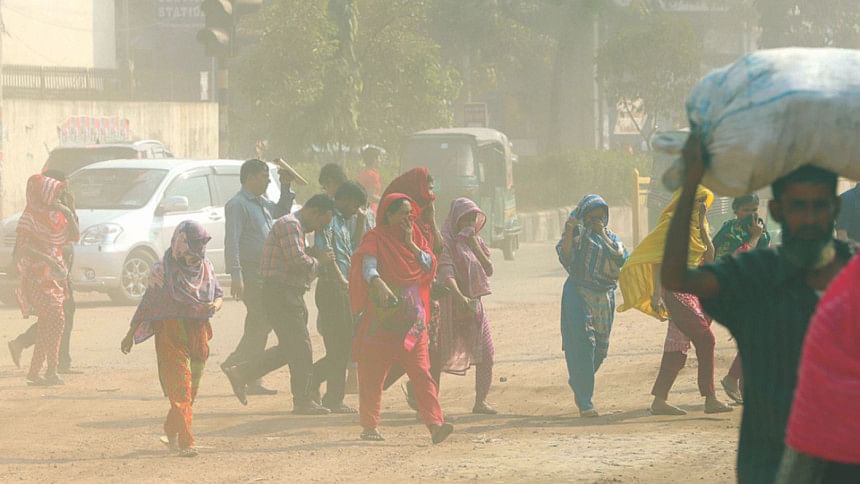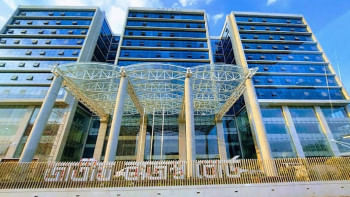How to reduce air pollution effectively

Ensuring clean air is one of the major environmental challenges in Bangladesh's larger cities. Although air quality management is a key component of environmental issues, its mismanagement may have a huge adverse impact on the overall socioeconomic development of a country. Recent evidence shows that air quality is deteriorating in many parts of the world, with low- and middle-income countries especially susceptible to the danger.
According to the World Health Organization (WHO), about 98 percent cities of low- and middle-income countries do not meet the WHO air quality guidelines, while this percentage decreases to 56 percent in high-income countries. However, in a study on the air quality standards of 3,000 cities in 103 countries, some major Bangladeshi cities like Dhaka, Narayanganj, Gazipur, Chittagong, Barisal, Khulna and Sylhet were placed at the top of the list. In general, the air quality of these cities has a high impact on public health, increasing chances of stroke, heart disease, lung cancer, and chronic and acute respiratory diseases, including asthma.
To understand the importance of air quality management in the SDGs (Sustainable Development Goals), we need to take note of two particular goals—SDG 3 and SDG 11—in which air pollution is mentioned specifically. But the issue has many drivers and relevant sustainability impacts connecting almost 14 out of the 17 SDGs set by the United Nations. These goals and related targets and indicators are connected with several drivers, while the best outcome of ensuring clean air can be achieved through an integrated approach of air quality management. Otherwise, the dream behind the SDGs will remain unfulfilled.
In our cities, air pollution usually becomes most severe in the dry season (winter). If the city air pollution level is considered between summer and winter, then the control strategy should be separated from the overall management policy. The types of local pollutants and seasonal public health status could be assessed for effective air quality management. However, a control mechanism can be suggested in the context of our country, which requires that air-polluted cities are continuously evaluated and effective local measures are implemented. In general, there should be a strategy covering all aspects of air quality management in all the cities. The country's clean air act, for example, could be used based on multi-criteria evaluation conducted by multi-stakeholders.
Determining the priority pollutants helps develop the strategy for air quality control. In the context of location-specific pollutants, health problems arising from poor air quality will be measured to form a location-specific solution. For example, context-specific control system can be developed in areas where they are industrial zones, waste disposal sites, construction sites, marketplaces, etc. So, it's very important to identify the sources of air pollutants.
In our cities, we face an increasing level of dust pollutants around us, which is gradually becoming a serious health hazard with other pollutants in the air. So, developing a cost-effective air control strategy must involve incorporating control measures based on minimising the source points of dust as well. Other major source points—brick kilns, solid waste, construction (road and building mainly), and transportation system—should also be kept in mind considering the SDG targets and indicators.
On a personal level, citizens can also help reduce air pollution. They can, for example, drive less or wisely (e.g. avoiding unnecessary driving, using fuel-efficient vehicles and public transports, walking, cycling, etc.), promote home deliveries (e.g. online selling, buying, etc.), promote plantation (e.g. growing trees, gardening, etc.), and also ensure waste disposal in a sustainable manner (e.g. disposing waste in the way advised by waste removal experts).
However, an integrated system has to be developed to get better response in city air quality management. Under the sustainable framework, an air management system must satisfy three broad categories of requirements—environmental, engineering and economic sustainability. We have many constructive policies, rules and regulations for air quality management, but we lack enough programmes of compliance and enforcement, which not only reduce air pollution, but also help the owners of source points get information required for their control mechanism and also to further develop and update their system.
Usually, our policymakers take a conventional regulatory approach to the air control system. This system mainly sets specific standards for polluters in the industrial sectors. This may be a good step for one sector only, but the government should expand the mechanism to target all types of polluters and may offer economic incentives to reduce pollution at all levels of the points of origin. Though, currently, a limited incentive mechanism exists, but it can be expanded to include various programmes and events such as emission-related tax incentives, subsidies for waste treatment, deposit refund systems for disposal of different types of waste, etc.
Finally, our control strategy relies heavily on the regulatory authorities functioning within the SDG framework when we should, actually, encourage greater participation of the public in the system. With proper guidance, knowledge and motivation, the public can be made a crucial part of the air quality management.
Polin Kumar Saha is a senior research associate at BRAC Research and Evaluation Division.
Email: [email protected]

 For all latest news, follow The Daily Star's Google News channel.
For all latest news, follow The Daily Star's Google News channel. 



Comments